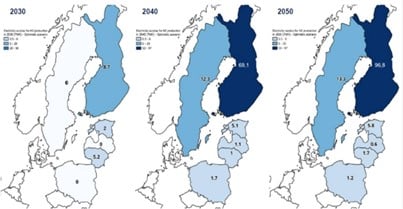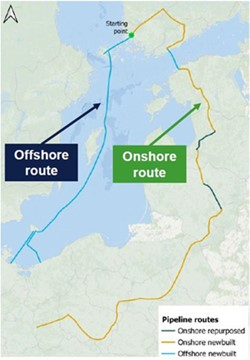DNV study indicates high potential of hydrogen in the Northern Baltic sea region
Finland could become an important hydrogen supplier for Germany, with a combination of offshore and onshore pipelines as optimal transport infrastructure
Hamburg, 16-05-2024 - Not only the North Sea, but also the Baltic Sea region holds considerable potential to produce cheap, green hydrogen, which could be a significant contribution to the diversification of sources and energy independence in Europe. This is the conclusion of the new DNV study "Potential for a Baltic Hydrogen Offshore Backbone".
The EU estimates the demand for climate-neutral hydrogen in 2050 at up to 2,000 terawatt hours (TWh). Part of this hydrogen could come from onshore wind farms in the Baltic Sea region. While the DNV Study saw high potential for offshore production of hydrogen in the North Sea (especially in areas more than 100 km from the coast), onshore hydrogen production in the Baltic Sea region is more favorable in neighboring countries.
Finland in particular could become an important hydrogen supplier: The export potential is 60-70 TWh of hydrogen per year in 2050, which corresponds to around 2.1 million tons of hydrogen. Due to its high proportion of renewable electricity in the power grid (compliance with RED III criteria), production costs (LCOH = levelized cost of hydrogen) of around 2.5 EUR/kg H2 can be achieved in Finland. In combination with favorable pipeline transport through the Baltic Sea, the system costs for green hydrogen are around 3 EUR/kg H2.
According to analyses conducted by GASCADE Gastransport, this would be half the cost assumed for hydrogen derivatives such as ammonia. Transported to Germany by ship, estimates here assume approx. 6 EUR/kg H2.

The study sees less production and export potential in Sweden, based on the current relatively low expansion targets for renewable energies in an already largely decarbonized environment.
The Baltic Sea region is favorable as a stable source not only from a geopolitical point of view: "If we know about such a large and comparatively inexpensive potential right on our doorstep, it would be criminal not to exploit it," emphasises GASCADE Managing Director Ulrich Benterbusch regarding to the need for energy supply security in the emerging hydrogen market.

in the Baltic Sea region
An offshore pipeline connection between the production sources and Germany presents itself as a comparatively inexpensive alternative for transportation:
In view of the transport infrastructure and the expected volumes, the study recommends a combination of offshore and onshore pipelines to diversify the connection. An offshore pipeline starting in Finland can not only transport quantities of the green hydrogen produced there. It can also potentially collect the produced energy carrier along the route, for example on the Åland Islands, Gotland and Bornholm. The onshore route runs via the Baltic states and Poland.
Quantities from this import corridor could be transported in Germany via the hydrogen project Flow - making hydrogen happen. It is part of the German hydrogen core network and is set to go into operation in a first step in 2025.
About GASCADE
GASCADE Gastransport GmbH operates a gas pipeline network throughout Germany. The Kassel-based transmission system operator offers its customers modern and competitive transport services for natural gas and, in future, other gases in the heart of Europe via its own high-pressure pipeline network, which is around 3,700 kilometres long. GASCADE is pursuing the goal of successively converting its pipeline network to transport hydrogen and is therefore active in several onshore and offshore hydrogen projects.
